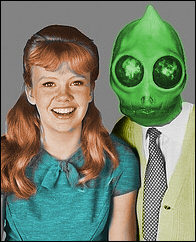Like the Jimmy Olsen & Thrilling Wonder covers, here is another example of the pulp serving as the inspiration for the comic book.
Amazing Stories, January 1927
Strange Adventures #5, February 1951
This is pretty blatant and I think less an homage than a direct rip, particuarly since the guys doing comics in the industry at the time were also very knowledgable about, if not involved in, the pulp industry in the past (particularly Edmund Hamilton).
The one difference being the age groups the magazines were meant for. It is obvious from just the covers the more adult demographic was the target of the 1927 pulp. The comic version of the concept apparently required the outline of a body to let the reader know there was an invisible person on the platform, when it was a clearly obvious element on both covers from the strategic placement of eyeglasses and personal accessories.
Pulps and comics evolved similarly over time, eventually borrowing ideas and elements from the other. But as time passed comics were seen more as the annoying little brother of the digests and paperback books the pulp magazines transformed into. In 1951 when Strange Adventures was published there were several pulp-like magazines still in existence, but they were fading and would soon disappear, finally giving up and mostly becoming as a genre-form the magazines we know today.
Tags: Art Swipe
Tuesday, September 06, 2005
Amazing Stories vs. Strange Adventures
Posted by
Sleestak
at
9/06/2005 08:59:00 PM
![]()
![]()
Subscribe to:
Post Comments (Atom)
























Are those...sock garters?! Man, I'll bet if that suit weren't invisible it would be bright lavender and crosshatched.
ReplyDeleteThe SA cover is actually more effective, IMO. The AS version just looks like the guy is scared witless by a variety of things suspended in midair. A high degree of realism in fantasy art is not always a good thing.
Well, that's why copyright can't cover the underlying idea. Nothing is ever done so well that someone can't do it better (or more in line with contemporary aesthetics) a decade later.